In: wine label design
22/06/2018
Blurring the Lines
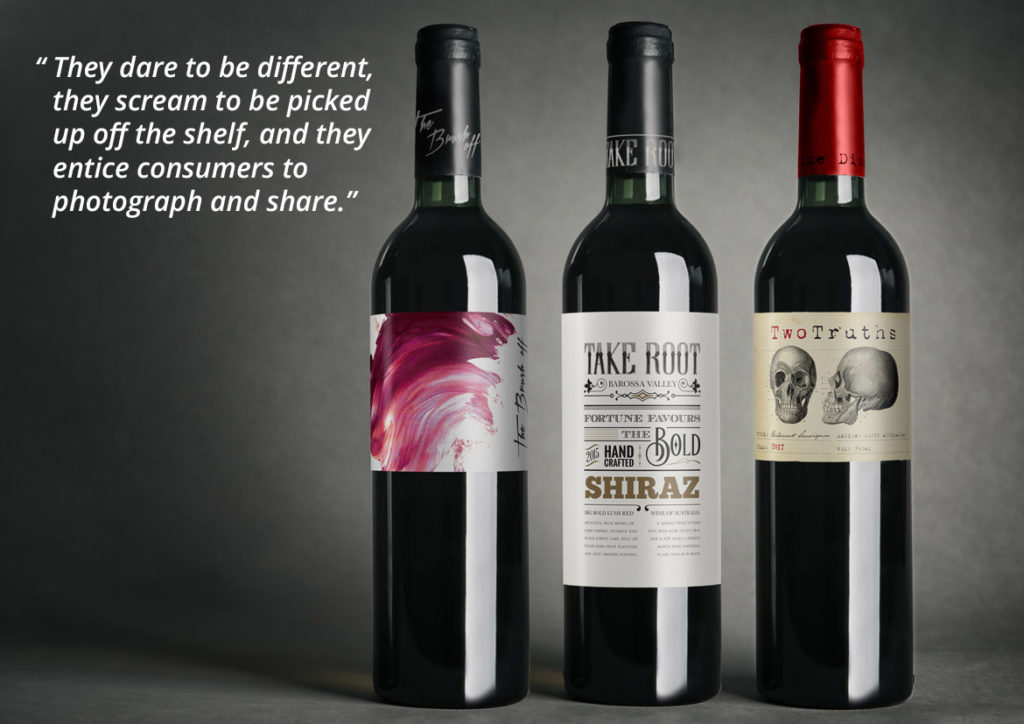
The wine industry has started to move away from the tradition of distinguished, stately wine labels and is trending towards the more youthful, out-there labels commonly employed by craft beers.
As consumers become more familiar with seeing these labels on their local bottle shop shelves, as well as on their hip inner-city café tables, they are coming to expect their wine labels to follow suit.
There are two key trends that have emerged as a result of this shift. The first are labels that are dominated by typography, lending a vintage, yet quirky feel. This was a trend that ignited about 10 years ago but quickly disappeared. It is now making a strong and decisive come back.
The second key trend is wine labels that don’t look like wine labels. They carry no distinguishable wine information on the front label and are primarily image driven. They dare to be different, they scream to be picked up off the shelf, and they entice consumers to photograph and share.
These shifts are already happening, with key markets being the UK, USA and China. If you’re interested in hearing more about these current wine label trends, as well as benefiting from John Jewell Design’s in depth understanding of the industry, contact the team on 02 6040 4433.
15/08/2017
Reshaping the Wine Industry
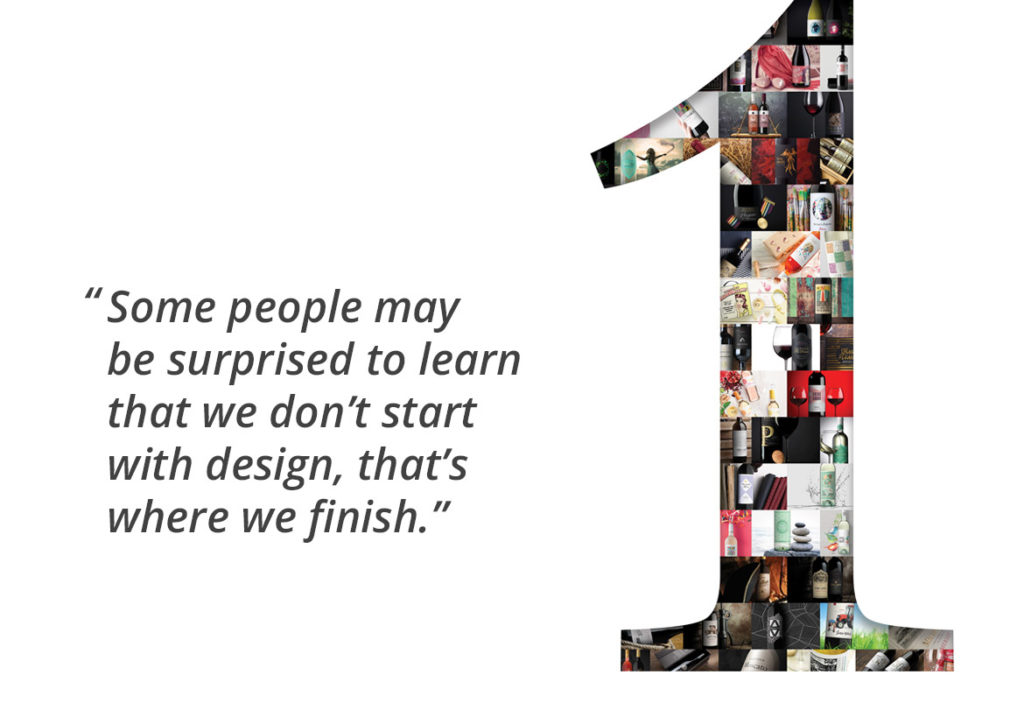
At John Jewell Design we invest in understanding trends. We don’t consider it a nicety, it’s a necessity. We research, we travel, we observe and we process all this knowledge to deliver designs for our clients that reflect emerging market needs.
Some people may be surprised to learn that we don’t start with design; that’s where we finish. We are fully immersed in the nuances and intricacies of the wine industry landscape, and it’s here that we find our starting point. This knowledge informs our design direction and how we advise our clients.
Whether it’s a private label design or a refresh of a current brand the rules are the same, always start with what’s driving the consumer at that point in time. We can fully understand our client’s needs because we are across the trends that will influence their customer’s buying habits and this allows us to give clients what they need: labels that drive results.
Trends in wine label design – as in any design-driven industry – tend to be cyclical, with labels that may have been popular a decade ago suddenly enjoying a revival among the masses. We’ve seen this recently with typographic labels and the art is in knowing how to rework these designs for a market that is split between those who nostalgically remember the first incarnation, and those who are experiencing this trend for the first time.
Clients can sometimes be hesitant to revisit past trends, but a willingness to take a calculated step back in time can often result in taking a big step forward.

In addition to being immersed in these trends, we also appreciate how imperative it is to constantly develop as an industry. To evoke real, meaningful change that continues to attract and captivate customers, we also need to be constantly pushing the envelope for what is possible. We are continually experimenting with designs, techniques and processes to develop label design concepts that have never been done before. This provides our clients with options that can’t be found elsewhere.
Customers are constantly changing and evolving. As an industry, we need to keep evolving too. At John Jewell Design we’re making a contribution to this evolution. One label at a time.
14/06/2017
Owning the Shelf
The wine can’t speak for itself when it’s sitting on a bottle shop shelf. It needs something to speak for it and that something is the wine label. Bottle shop shelves are a study in trying to be noticed, a plethora of options all screaming “Pick me! Pick me!” They’re all there for the same reason, and they’re all competing against each other to be the lucky one that ends up in the customer’s hands. So how do you make your label stand out from the masses?
How do you make your label stand out from the masses?
Good design is crucial, to the point now where it’s a moot point. Of course it’s important. No one sets out to emblaze their wine bottle with a label that they don’t think is worthy. But sometimes good design alone is not enough.
So if it’s not just design, what else is there in the ‘first-impressions last’ world of the bottle shop? The answer lies in the label itself. The stock, the print, the embellishments, they matter, and they all make a difference.
Picture two labels side by side with the same great design. Now imagine one is a standard print, nothing fancy – just ink on paper – whereas the one next to it utilises some strategic embossing, some carefully placed foiling, some artfully applied spot gloss varnish and custom die-cutting. These two labels may boast the exact same design, but the latter is suddenly alive, it radiates light, it intrigues with it’s depth, it exudes luxury and it calls to the customer on a level that the plain label can’t compete on.
And herein lies the challenge for wine businesses looking to create new labels; they need a designer who not only understands the design, but who also understands how embellishments can truly bring each label design to life.
Embellishment options are many and varied and each has its place and purpose; custom die-cutting allows the label to break free from the standard straight-edged mould, offering graceful curves and design hugging edges. And if die-cutting breaks free from the mould then screen printing directly onto the bottle completely breaks the mould, removing all constraints of traditional label printing and allowing complete freedom regarding placement. The use of varnish, either spot gloss or high build is a subtle but highly effective way to highlight key aspects of the label without being overt or gaudy, while foiling instantly lends an air of luxury through its use of metallic foils, most commonly gold and silver.
To make the most of these embellishments, the label needs to be designed with these options already in mind so that the label is created in tandem with its embellishments, the two working hand-in-hand to deliver a truly cohesive result.
So if you’re looking to create a new label and want a designer who knows the ins-and-outs of not only label design, but also label embellishments, contact the team.
19/03/2017
Emerging Wine Label Trends for 2017
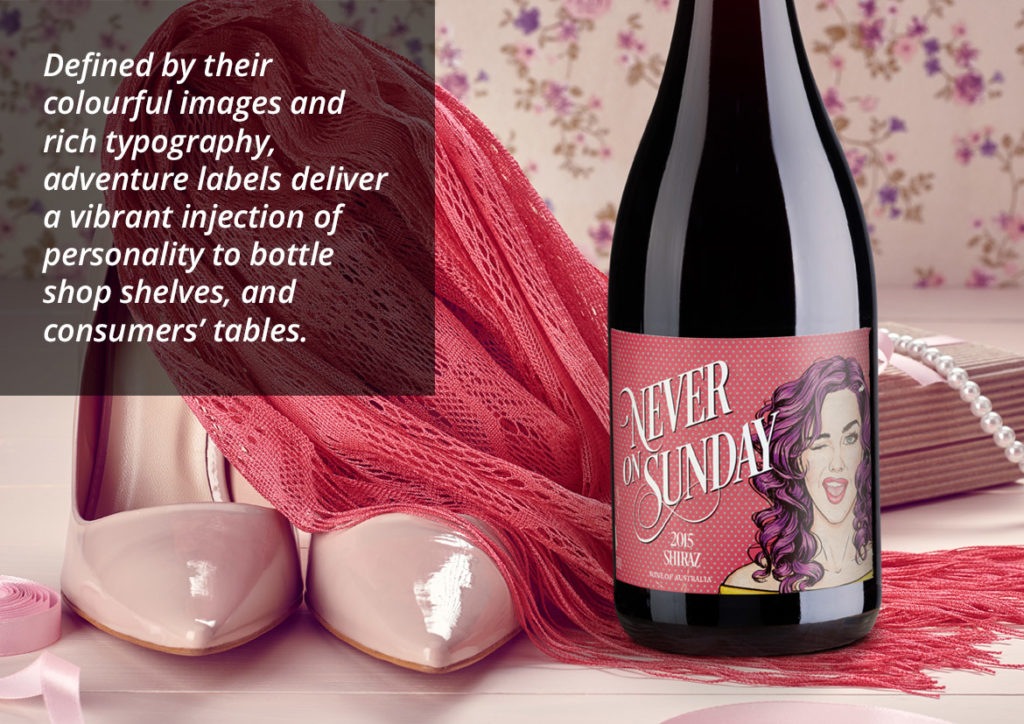
John’s travels always provide a wealth of knowledge regarding emerging trends and shifts in the market and his latest expeditions overseas were certainly no different. Want to know what role craft beers are playing and how drinks other than wines are leading the charge? Then read on….
The industry has started to move away from the tradition of distinguished, stately wine labels and is trending towards the more youthful, out-there labels commonly employed by craft beers. As consumers become more familiar with seeing these labels on their local bottle shop shelves, as well as on their hip inner-city café tables, they are coming to expect their wine labels to follow suit. They don’t want labels that just sit back and wait to be noticed, they want something that jumps out at them, grabs their attention and demands to be photographed for their social media feeds.
There are two key trends that have emerged as a result of this shift and interestingly the first is one that ignited about 10 years ago but disappeared almost as quickly as it appeared. We are talking about labels that are dominated by typography, lending a vintage, yet quirky feel. These often employ subtle uses of colour and occasional imagery but none of this distracts from the hero of the label, which is the typography. It’s bold, it’s confident and it’s making a comeback.

The second key trend is even more curious than the first in that they are wine labels that don’t look like wine labels. They carry no distinguishable wine information on the front label and could be at home on the front of any type of beverage. These labels are image driven, designed to immediately capture attention, evoke an emotion and start a conversation. They dare to be different, they scream to be picked up off the shelf, and they entice consumers to photograph and share. On the shelf, they rely on the bottle itself as the sole wine identifier, preferring to keep all wine-related information to the back of the bottle.

These shifts are already happening, with key markets being the UK, USA and China. If you’re interested in hearing more about these current wine label trends, as well as benefiting from John Jewell Design’s in depth understanding of the industry, contact the team.
06/11/2016
Online Wine Label Solutions
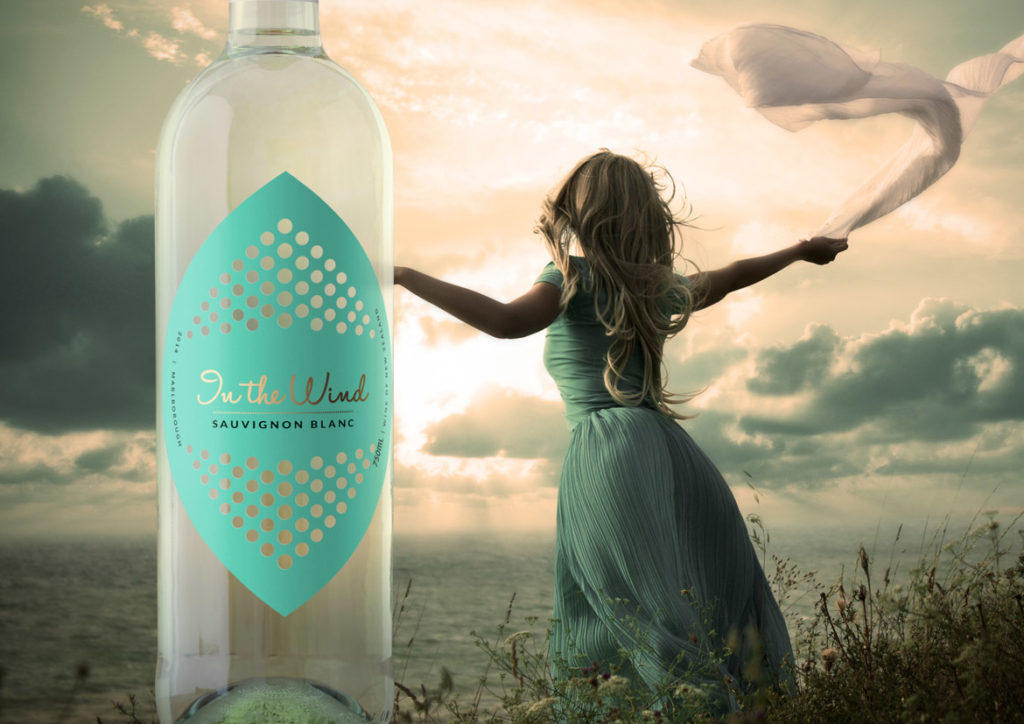
The benefits of buying off-the-shelf
It all starts with understanding your market, and then building a memorable brand that is brought to life through outstanding design. It’s about cutting through shelf clutter so your wine is the stand-out choice for your customer.
Here at John Jewell Design, we are constantly travelling and studying the wine markets around the world. This is to ensure our wine label offerings target the unique needs of the many different wine businesses, both here in Australia and abroad.
In addition to our extensive bespoke design services, we have used this expert knowledge to create a considered collection of wine label designs, all available for immediate perusal and purchase via the John Jewell Design website.
This online gallery takes the guesswork out of choosing a wine label by guiding you through the selection process. You can search by a particular design style, which is perfect for when you already have an idea about the type of label you require. Or alternatively, you can search by country, to be shown styles that are best suited to your specific market.
Depending on your requirements, you can also explore our different tiers, as we know every one has their own design needs and budgets. The VALUE section offers exactly that – fantastic front label designs at a pocket-friendly price. Or you can step up to the PREMIUM section if you require a full suite of design elements. All premium concepts include a unique brand name, a front label and back label design, plus capsule graphics. You can also search the Organic Wine Infusions section, which has been created specifically for this niche and emerging segment.
All label designs are print-ready and deliverable worldwide, resulting in fast turn-around times to get your product straight to market.
To protect the exclusivity of the labels on offer, access to the gallery is via invitation only. So if you’re in need of a new wine label and want to be guided by the best in the business, we invite you to get in touch today.
Contact Elise on please enable javascript to view or +61 (0)2 6040 4433 Monday to Thursday or send us your details and we’ll get back to you. Once approved we will email you your individual username and password.
11/07/2016
Trends in Labelling

While visiting Vinexpo Hong Kong, John sat down with the editor of VINEXPO Daily Magazine to share his thoughts on the latest trends in wine label design and branding.

Towards more funky, trendy design –the expert’s point of view
John Jewell Design was established in 1995 with the sole aim of creatinginnovative branding and labelling for the wine industry. We asked Johnto tell us a little more about his background…
When I started out I had two or threehundred clients in Australia and I woulddrive around and see people at theirvineyards. At that time there were 3,200winegrowers in Australia, and I realisedthat if we were only working on wine,the market was too small. So I went toLondon and had a meeting with MartinCampion, who was head of designfor Direct Wines, and after a shortmeeting we had his account. Today,our core markets are Australia, Chinaand Europe, especially in Norway andSweden.
What are the trends today?
Millennium buyers are the biggesttarget in the world today, and it’s a verydifficult one, because they rarely everbuy the same thing twice – so they’re amoving target. In the past six months, ascraft beer designs have been changingthe world’s thinking on designs andpackaging, the wine industry is tending to follow suit. A year or so ago in thewine industry it was all about stately,classic, distinguished products. Nowthey’re tending towards funky, trendy,out-there, look-different, and be loudoff the shelf. I see a major trend aroundthe world as following what craft beershave done.
What’s the secret to a successful design job?
You can design whatever you like,but it has to be economically viable.Printing techniques vary greatly aroundthe world. We’ve done a lot of sleevedesign work, but production aroundthe world is a bit of a problem withsleeves. Screen-printing on bottles looksfantastic, but logistically, you have aproblem. The world market is looking forsomething new in wine, and our HolyGrail is trying to find out what the nextbig trend will be!
Read the full issue here >
How do you tackle a rebrand when the current imagery is steeped in history and tradition? You look to the past to provide inspiration for the future. This is exactly what the John Jewell Design team did to deliver a refresh and relaunch of the Buller Wines winery and business…
What is Branding?
Branding is the art of imbuing a product with its own unique and authentic personality, making it attractive and memorable to new and loyal customers.
Who are Buller Wines?
The Buller Wines story was born in the early 1920’s when Reginald Buller purchase a vineyard in Rutherglen and named it Calliope after the famed ship that survived against all odds in the 1880’s. The vineyards, the family and the wine brand continued to evolve through the years and in 2013 the Judd family took the helm and have continued its growth and success.
The Challenge
The Calliope ship is an integral part of the Buller Wines story and imagery however the existing illustration was in need of a modern refresh. Given Calliope was a real vessel the first challenge was to ensure that any new imagery stayed true to the appearance of the original ship. The second challenge was in delivering new imagery that could convey the history of the brand but in a contemporary style that would work successfully across both small and large format requirements.
The Solution
In tackling the rebrand, the John Jewell Design team knew where they had to start. They took the time to look back through the history books and unearthed a bold image of the Calliope, showing it at full mast with a strong, commanding presence.
The image was then skilfully illustrated to best represent the authenticity and integrity of the long established Buller brand and it was then integrated into the brand’s logo and rolled out across labels, printed and electronic collateral and advertising.
In Closing
Rebranding isn’t always about coming up with something new; sometimes it’s about going back to the beginning to draw inspiration for the future. This was definitely the case for the Buller Wine rebrand. To find out how John Jewell Design can help you breathe new life into your brand, contact us.
24/01/2016
Wine Infusions
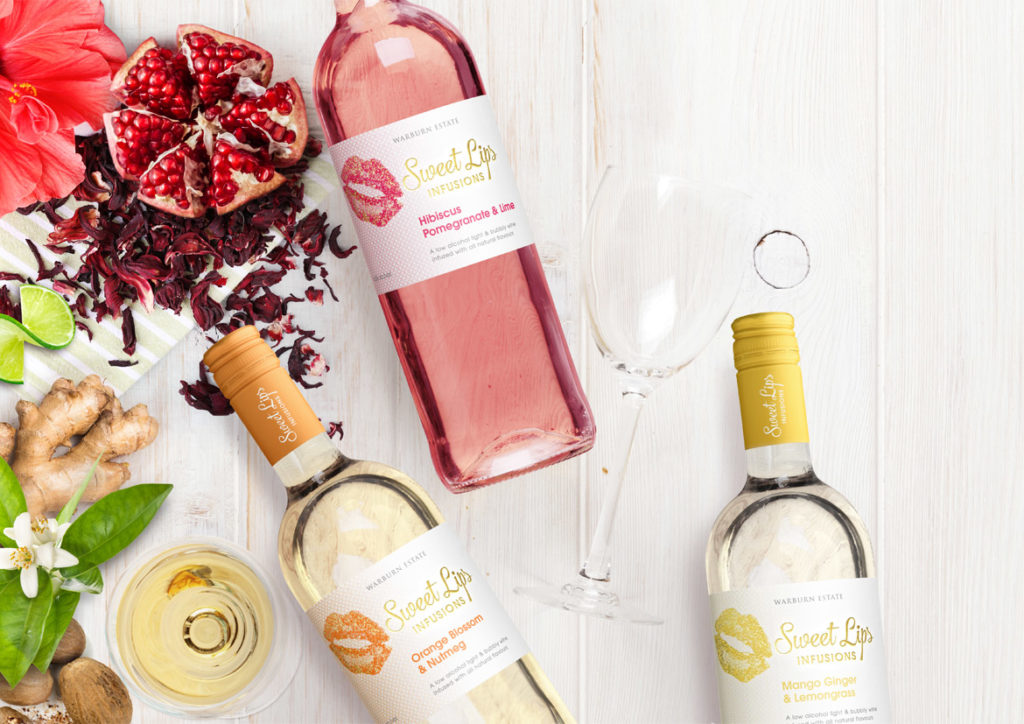
The whispers about wine infusions are now a buzz that cannot be ignored.
Led by European trends, predominately from Germany and the Netherlands, this category is growing rapidly. Winemakers and retailers alike are making strong moves towards wine infusions in an effort to secure the coveted 18-24 female demographic.
But what exactly is it that attracts consumers to wine infusions, and how can your label design capitalise on this trend?
There’s a whole host of reasons why wine infusions are generating so much interest amongst consumers. First and foremost, wine infusions are both lower in alcohol and lower in calories. For 18-24 year old females – who are generally very health conscious – this alone is hugely enticing.
Secondly, the addition of natural plant and fruit flavours means the wine infusions have a hint of sweetness that makes for a far more palatable drinking experience for those new to the world of wine. This, combined with the addition of a light spritz, makes for an overall easy drinking experience, particularly served over ice in the warmer months.
To a wine novice, the “rules” around wine can be confusing, and traditional wine blends are often perceived as harsh and too dry for an untrained palate. Fruit-driven infusions remove the mysticism around wine, providing a sweet, satisfying entry point for new consumers.
All this must be kept in mind when developing labels for wine infusion brands. It’s important to ensure the labels are both accessible and engaging to appeal to the new generation of wine consumer, steering clear of any old-world wine label cues. Labels should be bright and fun, reflecting the vibrant colours of the wine infusions themselves, whilst maintaining an overall finish that is both fresh and uncluttered.
The recently designed Sweet Lips reflects the above thinking. The label employs vibrant, striking colour that simultaneously draws the eye and acts as a subconscious cue to the flavours within. The vivid colours are given room to shine on a crisp white background with minimal distractions, while the use of gold foil adds a premium feel to the label.
If you’re interested in developing your own wine infusion brand, John Jewell Design has a range of off-the-shelf options available on their website for you to review and purchase. Check them out here.
08/06/2015
The Impact of a Wine Label
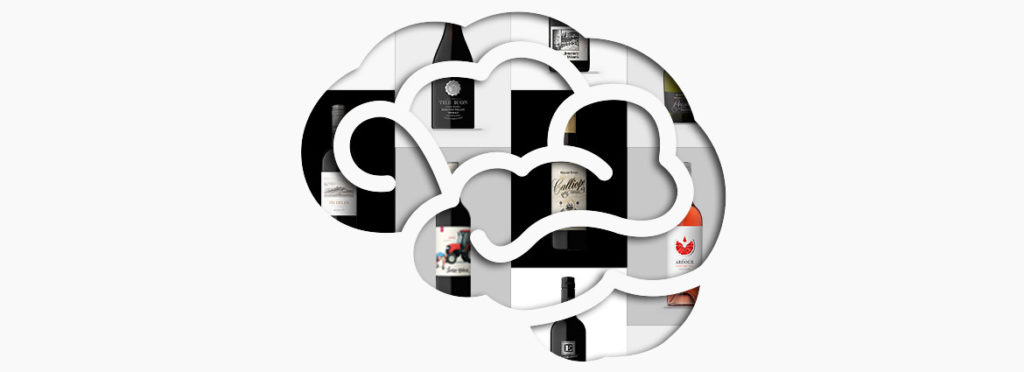
Why are labels so important to our wine-buying choices?
In a busy bottleshop, where shelves are crowded and the choice can be overwhelming, it’s not the winemaker’s resume or even the price that will sell your wine. Learnings from consumer psychology tell us that most wine sales are made purely on the strength of a label.
The reality is most consumers aren’t connoisseurs; they are customers looking to buy an experience.
What their searching eyes see on your wine label lays the foundations for that experience. Purposeful and carefully crafted visual cues subtly influence perceptions of price, quality and even taste.
To encourage a hand to reach deeper into their pocket, consumers expect to see labels that feature minimalist, uncluttered designs and an elegant, refined font. Adding texture – such as embossing – provides a tactile feature that activates increased perceptions of price and correlates with heightened anticipation and an increased drinking experience.
To sell a wine at a value-for-money price point, labels need to visually jump off the shelf through the careful construction of bright colours, bold, fun graphics and quirky or unique fonts.
At the end of the day, your label sets the tone for your customer’s experience and is often as important – if not more important – in driving the sale than the wine itself.
John Jewell spends several months every year traveling the world and acquiring insights into consumer psychology, preferences and trends to bring back home and translate into eye-catching, award-winning labels for his clients. If you have a label or brand that could benefit from John’s experience and knowledge, give him a call on: +61 (0)2 6040 4433 or send him an email.
04/03/2015
New Work: Fruit Ardour Wine Label Design
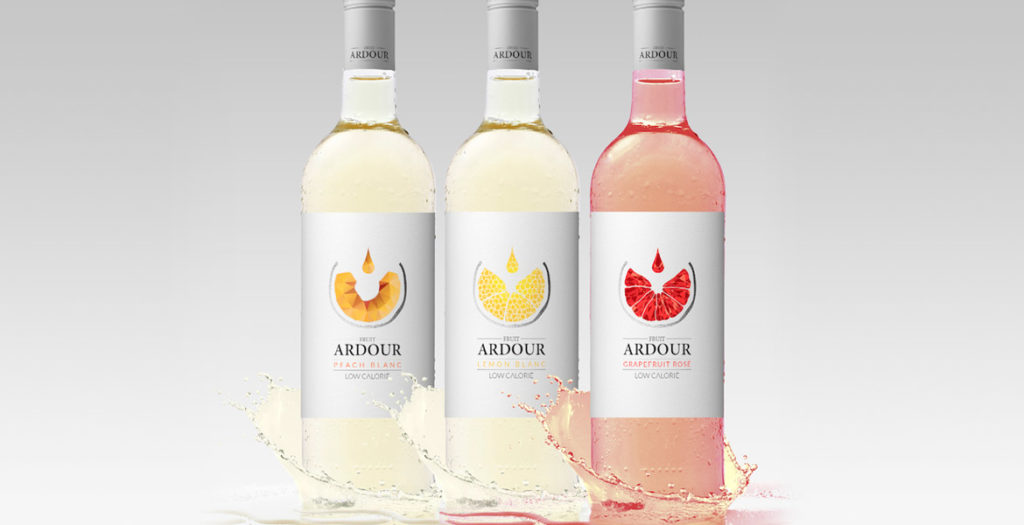
Fruit wine is the rising star of the wine market and with it comes the challenge of simultaneously appealing to a new-style of wine drinker, while also engaging the seasoned palate.
This new wave of wine is recognizable by its colourful and fun labels. The design challenge is to harness this youthful exuberance while simultaneously appealing to the traditional wine connoisseur. With Fruit Ardour, the brief was to develop a label that had strong wine cues, delivering a more serious offering whilst still emphasising the fruit aspect.
This brief was achieved primarily through the sophisticated and subtle use of colour and white space. The simple, uncluttered white background is reminiscent of high-end wine labels, whilst the singular use of colour delivers easy varietal differentiation without heading into “juice box” territory. Silver capsules provide continuity across the range, and add to the sophisticated finish.
The central graphic represents both wine being poured into a glass, as well as a geometric visual of the specific fruit, further emphasising the fruit connection but doing so within the domain of wine.
The resulting labels effortlessly combine the best of traditional wine with the modern vibrancy of fruit wines.
03/12/2014
New Work: Fractal Wine Label Design
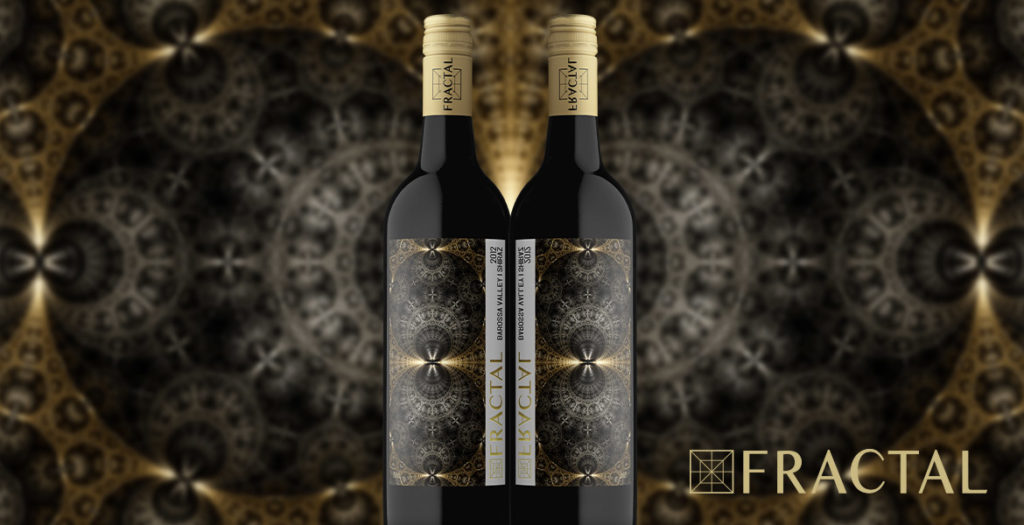
In creating the Fractal wine label, John Jewell Design was tasked with turning winemaker Bruce Clugston’s concept into reality. With a background in mathematics, Bruce was intrigued by fractal designs – structured mathematic formulae which give rise to beautiful patterns – and was searching for a way to utilise these captivating images on a wine label.
Bruce engaged the team at John Jewell Design, whose first task was to research fractal images and then search the globe for somebody who could produce the right designs utilizing this specific mathematical technique. A digital artist was finally located in the USA, and a consultative process began to source designs that best reflected the wines they would adorn.
The chosen images, once skilfully structured to work within the realm of a wine label, were then further enhanced by the use of fragmented foil, designed to give the patterns even more depth, as well as to illustrate the premium nature of the wines. In addition to the foiling, the packaging is further enriched by the use of gold and silver capsules. The final product is a stunning representation of Bruce’s initial vision and John Jewell Design’s knowledge and expertise.
If you’ve got an idea for a label and need the expertise of an award-winning design firm to help bring it to life, contact John Jewell Design.
A word from Bruce Clugston…
The fractal labels look amazing… They should win awards… Thank you to everyone.
Bruce Clugston, Wineinc
When updating the look and feel of an established brand, it is important to build on the brand’s heritage, to improve on their strengths and appeal to a new generation of consumers without alienating existing relationships. This is something John Jewell Design kept in mind when working with the internationally recognised Stanton & Killeen range.
The brief was to create a range of labels that reflected a sense of place and touched on the long history of the winery.
John Jewell Design developed a comprehensive look and feel that is truly in sync with the overall brand identity. From the Icon range through to the Limited Release, Premium and Everyday range the new labels project a sense of heritage and quality, with the use of rich gold speaking to the distinguished nature of the wines.
We feel the new labels stay true to our 140 year history, yet also invite new people to connect with our brand using contemporary design elements.Natasha Killeen
John Jewell Design also rebuilt the Stanton & Killeen Wines website which was very outdated in both look and functionality. Launched in February this year the new site has been a great success creating a modern, user-friendly design that unifies the Stanton & Killeen brand.




















